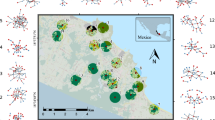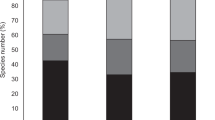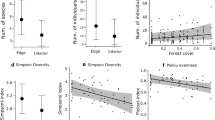Abstract
Context
Understanding the relative contributions of spatial and environmental processes on community assembly is a central question in ecology. Despite this long-standing interest, our understanding of how landscape structure may drive spatial processes of community assembly remains poorly understood in part because of the challenge of tracking community assembly across landscapes and quantifying key aspects of landscapes that may impact assembly processes.
Objectives
We examined the roles of spatial and environmental processes on structuring assemblies of ants in 72 cleared patches embedded within a forested landscape.
Methods
To examine the role of spatial processes, we contrasted the use of geographic distances between patches and effective distances estimated from connectivity modeling accounting for matrix vegetation structure hypothesized to be important for ant community assembly. To examine the role of environmental processes, we quantified patch age and abundance of a key competitor and invasive species, the fire ant Solenopsis invicta.
Results
We found evidence for the importance of both spatial and environmental processes in structuring ant communities. When spatial processes were quantified as geographic distance, environmental variables were the predominant factors accounting for variation in ant community dissimilarity among patches. However, accounting for matrix resistance with circuit-theoretic connectivity modeling resulted in higher accounting of variation in ant community dissimilarity than geographic distance and changed the predominant variables accounting for that variation from environmental to spatial processes.
Conclusions
These findings show that accounting for connectivity through the matrix can be decisive in determining the primary drivers of community assembly.


Similar content being viewed by others
References
Andersen AN (2019) Responses of ant communities to disturbance: five principles for understanding the disturbance dynamics of a globally dominant faunal group. J Anim Ecol 88:350–362. https://doi.org/10.1111/1365-2656.12907
Anderson MJ (2011) Navigating the multiple meanings of beta diversity: a roadmap for the practicing ecologist. Ecol Lett 14:210–210
Benito X, Fritz SC, Steinitz-Kannan M, Velez MI, McGlue MM (2018) Lake regionalization and diatom metacommunity structuring in tropical South America. Ecology and Evolution 8:7865–7878
Biswas SR, Wagner HH (2012) Landscape contrast: a solution to hidden assumptions in the metacommunity concept? Landscape Ecol 27:621–631
Bivand R, Keitt T (2019) rgdal: Bindings for the 'Geospatial' Data Abstraction Library, R package version 1.5–16.
Bray JR, Curtis JT (1957) An ordination of the upland forest communities of southern Wisconsin. Ecol Monogr 27:326–349
Brodie JF, Mohd-Azlan J, Schnell JK (2016) How individual links affect network stability in a large-scale, heterogeneous metacommunity. Ecology 97:1658–1667
Brudvig LA, Leroux SJ, Albert CH, Bruna EM, Davies KF, Ewers RM, Levey DJ, Pardini R, Resasco J (2017) Evaluating conceptual models of landscape change. Ecography 40:74–84. https://doi.org/10.1111/ecog.02543
Cadotte MW, Tucker CM (2017) Should environmental filtering be abandoned? Trends Ecol Evol 32:429–437
Camilo GR, Phillips SAJ (1990) Evolution of ant communities in response to invasion by the fire ant Solenopsis invicta. In: Vander Meer RK, Jaffe K, Cedeno A (eds) Applied Myrmecology: A World Perspective. Westview Press, Boulder, CO, USA, pp 191–198
Cerdá X, Arnan X, Retana J (2013) Is competition a significant hallmark of ant (Hymenoptera: Formicidae) ecology? Myrmecol News 18:131–147
Chao A, Colwell RK, Lin CW, Gotelli NJ (2009) Sufficient sampling for asymptotic minimum species richness estimators. Ecology 90:1125–1133
Connell JH (1961) The influence of interspecific competition and other factors on the distribution of the barnacle Chthamalus stellatus. Ecology 42:710–723
Cottenie K (2005) Integrating environmental and spatial processes in ecological community dynamics. Ecol Lett 8:1175–1182
Damschen EI, Brudvig LA, Burt MA, Fletcer RJ, Haddad NM, Levey DJ, Orrock JL, Resasco J, Tewksbury JJ (2019) Ongoing accumulation of plant diversity through habitat connectivity in an 18-year experiment. Science 365:1478–1480. https://doi.org/10.1126/science.aax8992
Dhami MK, Booth K (2008) Review of dispersal distances and landing site behaviour of Solenopsis invicta Buren, Red Imported Fire Ant (RIFA) Centre for Biodiversity and Biosecurity. University of Auckland Wellington, New Zealand, School of Biological Sciences
Dickson BG, Albano CM, Anantharaman R, Beier P, Fargione J, Graves TA, Gray ME, Hall KR, Lawler JJ, Leonard PB, Littlefield CE, McClure ML, sNovembre J, Schloss CA, Schumaker NH, Shah VB, Theobald DM (2019) Circuit-theory applications to connectivity science and conservation. Conserv Biol 33:239–249. https://doi.org/10.1111/cobi.13230
Didham RK, Tylianakis JM, Hutchison MA, Ewers RM, Gemmell NJ (2005) Are invasive species the drivers of ecological change? Trends Ecol Evol 20:470–474
Dong XY, Li B, He FZ, Gu Y, Sun MQ, Zhang HM, Tan L, Xiao W, Liu SR, Cai QH (2016) Flow directionality, mountain barriers and functional traits determine diatom metacommunity structuring of high mountain streams. Sci Rep-Uk 6:24711. https://doi.org/10.1038/srep24711
Dormann CF, Elith J, Bacher S, Buchmann C, Carl G, Carre G, Marquez JRG, Gruber B, Lafourcade B, Leitao PJ, Munkemuller T, McClean C, Osborne PE, Reineking B, Schroder B, Skidmore AK, Zurell D, Lautenbach S (2013) Collinearity: a review of methods to deal with it and a simulation study evaluating their performance. Ecography 36:27–46. https://doi.org/10.1111/j.1600-0587.2012.07348.x
Etherington TR (2016) Least-cost modelling and landscape ecology: concepts, applications, and opportunities. Current Landscape Ecology Reports 1:40–53
Ferrier S, Manion G, Elith J, Richardson K (2007) Using generalized dissimilarity modelling to analyse and predict patterns of beta diversity in regional biodiversity assessment. Divers Distrib 13:252–264
Fitzpatrick MC, Mokany K, Manion G, Lisk M, Ferrier S, Nieto-Lugilde D (2020) gdm: Generalized Dissimilarity Modeling. R package version 1(4):2
Fitzpatrick MC, Sanders NJ, Normand S, Svenning JC, Ferrier S, Gove AD, Dunn RR (2013) Environmental and historical imprints on beta diversity: insights from variation in rates of species turnover along gradients. P Roy Soc B-Biol Sci. https://doi.org/10.1098/rspb.2013.1201
Fletcher RJ, Sefair JA, Wang C, Poli CL, Smith TAH, Bruna EM, Holt RD, Barfield M, Marx AJ, Acevedo MA (2019) Towards a unified framework for connectivity that disentangles movement and mortality in space and time. Ecol Lett 22:1680–1689. https://doi.org/10.1111/ele.13333
Fletcher RJ, Burrell NS, Reichert BE, Vasudev D, Austin JD (2016) Divergent perspectives on landscape connectivity reveal consistent effects from genes to communities. Current Landscape Ecology Reports 1:67–79
Fletcher R, Fortin M-J (2018) Spatial ecology and conservation modeling: applications with R, 1st edn. Springer, New York
Germain RM, Mayfield MM, Gilbert B (2018) The “filtering” metaphor revisited: competition and environment jointly structure invasibility and coexistence. Biol Letters. https://doi.org/10.1098/rsbl.2018.0460
Gibb H, Grossman BF, Dickman CR, Decker O, Wardle GM (2019) Long-term responses of desert ant assemblages to climate. J Anim Ecol 88:1549–1563
Gotelli NJ, Arnett AE (2000) Biogeographic effects of red fire ant invasion. Ecol Lett 3:257–261
Gotelli NJ, Colwell RK (2011) Estimating species richness. In: Magurran AE, McGill BJ (eds) Biological Diversity: Frontiers in Measurement and Assessment. Oxford University Press, New York, pp 39–54
Gotelli NJ, Ellison AM, Dunn RR, Sanders NJ (2011) Counting ants (Hymenoptera: Formicidae): biodiversity sampling and statistical analysis for myrmecologists. Myrmecol News 15:13–19
Greenslade PJM (1973) Sampling ants with pitfall traps: digging-in effects. Insect Soc 20:343–353
Hanski I (1994) A practical model of metapopulation dynamics. J Anim Ecol 63:151–162
Hartfelder J, Reynolds C, Stanton RA, Sibiya M, Monadjem A, McCleery RA, Fletcher RJ (2020) The allometry of movement predicts the connectivity of communities. Proc Natl Acad Sci. https://doi.org/10.1073/pnas.2001614117
Helms JA (2018) The flight ecology of ants (Hymenoptera: Formicidae). Myrmecol News 26:19–30
Hijmans RJ (2020) raster: Geographic Data Analysis and Modeling, R package version 3.3–13.
Hölldobler B, Wilson EO (1990) The ants. Belknap Press of Harvard University Press, Cambridge, Mass
Holway DA, Lach L, Suarez AV, Tsutsui ND, Case TJ (2002) The causes and consequences of ant invasions. Annu Rev Ecol Syst 33:181–233
Hutchinson GE (1978) An Introduction to Population Ecology. Yale University Press, New Haven
Jusino-Atresino R, Phillips SAJ (1994) Impact of Red Imported Fire Ants on the Ant Fauna of Central Texas. In: Williams DF (ed) Exotic Ants: Biology, Impact, and Control of Introduced Species. Westview Press, Boulder, CO, USA, pp 259–268
Kilgo JC, Blake JI (2005) Ecology and Management of a Forested Landscape: Fifty Years on the Savannah River Site. Island Press, Washington
King JR, Tschinkel WR (2008) Experimental evidence that human impacts drive fire ant invasions and ecological change. P Natl Acad Sci USA 105:20339–20343
King JR, Tschinkel WR (2013) Experimental evidence for weak effects of fire ants in a naturally invaded pine-savanna ecosystem in north Florida. Ecol Entomol 38:68–75
King JR, Tschinkel WR (2016) Experimental evidence that dispersal drives ant community assembly in human-altered ecosystems. Ecology 97:236–249
Kraft NJB, Adler PB, Godoy O, James EC, Fuller S, Levine JM (2015) Community assembly, coexistence and the environmental filtering metaphor. Funct Ecol 29:592–599
Lach L, Hooper-Bùi LM (2010) Consequences of ant invasions. In: Lach L, Parr CL, Abbott KL (eds) Ant Ecology. Oxford Univeristy Press Inc., New York, NY, USA, pp 261–286
LeBrun EG, Plowes RM, Gilbert LE (2012) Imported fire ants near the edge of their range: disturbance and moisture determine prevalence and impact of an invasive social insect. J Anim Ecol 81:884–895
Legendre P, Legendre L (2012) Numerical Ecology. Developments in environmental modelling, vol 24. Elsevier, Amsterdam
Leibold MA, Holyoak M, Mouquet N, Amarasekare P, Chase JM, Hoopes MF, Holt RD, Shurin JB, Law R, Tilman D, Loreau M, Gonzalez A (2004) The metacommunity concept: a framework for multi-scale community ecology. Ecol Lett 7:601–613
Logue JB, Mouquet N, Peter H, Hillebrand H, Grp MW (2011) Empirical approaches to metacommunities: a review and comparison with theory. Trends Ecol Evol 26:482–491
MacArthur RH, Wilson EO (1967) The theory of island biogeography. Monographs in population biology, vol [1]. Princeton University Press, Princeton
MacDougall AS, Turkington R (2005) Are invasive species the drivers or passengers of change in degraded ecosystems? Ecology 86:42–55. https://doi.org/10.1890/04-0669
MacGown JA (2003) Ants (Formicidae) of the southeastern United States. Mississippi Entomological Museum, Mississippi State University https://mississippientomologicalmuseum.org.msstate.edu/Researchtaxapages/Formicidaepages/Identification.Keys.htm. Accessed 2010
Markin GP, Diller JH, Hill SO, Blum MS, Hermann HR (1971) Nuptial flight and fight ranges of the imported fire ant Solenopsis saevissima richteri (Hymenoptera: Formicidae). Journal of the Georgia Entomological Society 6:145–156
McGaughey RJ, Reutebuch SE (2009) Savannah River Site 2009 LIDAR Project, FY09 Final Report. USDA Forest Service,
McRae BH, Beier P (2007) Circuit theory predicts gene flow in plant and animal populations. P Natl Acad Sci USA 104:19885–19890
McRae BH, Dickson BG, Keitt TH, Shah VB (2008) Using circuit theory to model connectivity in ecology, evolution, and conservation. Ecology 89:2712–2724
Minor ES, Tessel SM, Engelhardt KAM, Lookingbill TR (2009) The role of landscape connectivity in assembling exotic plant communities: a network analysis. Ecology 90:1802–1809
Morris JR, Steigman KL (1993) Effects of Polygyne Fire Ant Invasion on Native Ants of a Blackland Prairie in Texas. Southwest Nat 38:136–140
Oksanen J, Kindt R, Legendre P, O’Hara R, Simpson GL, Solymos P, Stevens MHH, Wagner H (2010) Vegan: Community Ecology Package, R package version 2.5–6
Parr CL, Gibb H (2010) Competition and the role of dominant ants. In: Lach L, Parr CL, Abbott KL (eds) Ant Ecology. Oxford University Press, New York, NY USA, pp 77–96
Parresol BR, Scott DA, Zarnoch SJ, Edwards LA, Blake JI (2017) Modeling forest site productivity using mapped geospatial attributes within a South Carolina Landscape, USA. Forest Ecol Manag 406:196–207
Pebesma EJ, Bivand RS (2005) Classes and methods for spatial data in R. R News 5
Poff NL (1997) Landscape filters and species traits: Towards mechanistic understanding and prediction in stream ecology. J N Am Benthol Soc 16:391–409
Porter SD, Savignano DA (1990) Invasion of polygyne fire ants decimates native ants and disrupts arthropod community. Ecology 71:2095–2106. https://doi.org/10.2307/1938623
Prugh LR, Hodges KE, Sinclair ARE, Brashares JS (2008) Effect of habitat area and isolation on fragmented animal populations. P Natl Acad Sci USA 105:20770–20775
Punttila P, Haila Y, Pajunen T, Tukia H (1991) Colonisation of clearcut forests by ants in the southern Finnish taiga: a quantitative survey. Oikos 61:250–262
R Core Team (2020) R: A Language and Environment for Statistical Computing. R Foundation for Statistical Computing, Vienna, Austria
Resasco J, Haddad NM, Orrock JL, Shoemaker D, Brudvig TA, Damschen EI, Tewksbury JJ, Levey DJ (2014) Landscape corridors can increase invasion by an exotic species and reduce diversity of native species. Ecology 95:2033–2039
Ricketts TH (2001) The matrix matters: effective isolation in fragmented landscapes. Am Nat 158:87–99
Roeder KA, Penuela Useche V, Levey DJ, Resasco J (in review) Testing effects of invasive fire ants and disturbance on ant communities of the longleaf pine ecosystem. Ecol Entomol
Sanders NJ, Gotelli NJ, Heller NE, Gordon DM (2003) Community disassembly by an invasive species. P Natl Acad Sci USA 100:2474–2477
Soininen J, McDonald R, Hillebrand H (2007) The distance decay of similarity in ecological communities. Ecography 30:3–12
Stuble KL, Chick LD, Rodriguez-Cabal MA, Lessard J-P, Sanders NJ (2013) Fire ants are drivers of biodiversity loss: a reply to King and Tschinkel (2013). Ecol Entomol 38:540–542
Tilman D (1977) Resource competition between plankton algae: an experimental and theoretical approach. Ecology 58:338–348
Tschinkel WR (2006) The Fire Ants. The Belknap Press of Harvard University Press, Cambridge, Mass
Tschinkel WR, King JR (2007) Targeted removal of ant colonies in ecological experiments, using hot water. Journal of Insect Science 7:1–12
Underwood EC, Fisher BL (2006) The role of ants in conservation monitoring: if, when, and how. Biol Conserv 132:166–182
van Etten J (2017) R package gdistance: distances and routes on geographical grids. J Stat Softw 76:1–21
Vasconcelos HL, Vilhena JMS, Magnusson WE, Albernaz ALKM (2006) Long-term effects of forest fragmentation on Amazonian ant communities. J Biogeogr 33:1348–1356
Vellend M (2010) Conceptual synthesis in community ecology. Q Rev Biol 85:183–206
Vellend M (2016) The Theory of Ecological Communities. Monographs in population biology, vol 57. Princeton University Press, Princeton
Wagner HH, Fortin MJ (2005) Spatial analysis of landscapes: concepts and statistics. Ecology 86:1975–1987
Watling JI, Nowakowski AJ, Donnelly MA, Orrock JL (2011) Meta-analysis reveals the importance of matrix composition for animals in fragmented habitat. Global Ecol Biogeogr 20:209–217
Wickham H (2007) Reshaping data with the reshape package. J Stat Softw 21:1–20
Wiens JA (1997) Metapopulation dynamics and landscape ecology. In: Gilpin ME (ed) Hanski I. Metapopulation Biology - Ecology, Genetics and Evolution, pp 43–62
Williams DF (1994) Exotic Ants: Biology, Impact, and Control of Introduced Species. Westview Press, Boulder, CO, USA
Wojcik DP (1994) Impact of Red Imported Fire Ants on Native Ant Species in Florida. In: Williams DF (ed) Exotic Ants: Biology, Impact, and Control of Introduced Species. Westview Press, Boulder, CO, USA, pp 269–281
Wojcik D, Allen CR, Brenner RJ, Forys EA, Jouvenaz D, Lutz RS (2001) Red imported fire ants: impact on biodiversity. Am Entomol 47:16–23
Acknowledgements
We thank the USDA Forest Service–Savannah River for facilitating this research, especially John Blake, Andy Horcher, Ed Olson, Kim Wright, and Anne Poole. We thank Hannah Penn for assistance in the lab. This research was supported by an NSF-GRFP and by funds provided to the USDA Forest Service-Savannah River, under Interagency Agreement DE-AI09- 00SR22188 with DOE, Aiken, South Carolina. The authors declare no conflict of interest.
Author information
Authors and Affiliations
Corresponding author
Additional information
Publisher's Note
Springer Nature remains neutral with regard to jurisdictional claims in published maps and institutional affiliations.
Rights and permissions
About this article
Cite this article
Resasco, J., Fletcher, R.J. Accounting for connectivity alters the apparent roles of spatial and environmental processes on metacommunity assembly. Landscape Ecol 36, 1089–1099 (2021). https://doi.org/10.1007/s10980-021-01203-z
Received:
Accepted:
Published:
Issue Date:
DOI: https://doi.org/10.1007/s10980-021-01203-z




